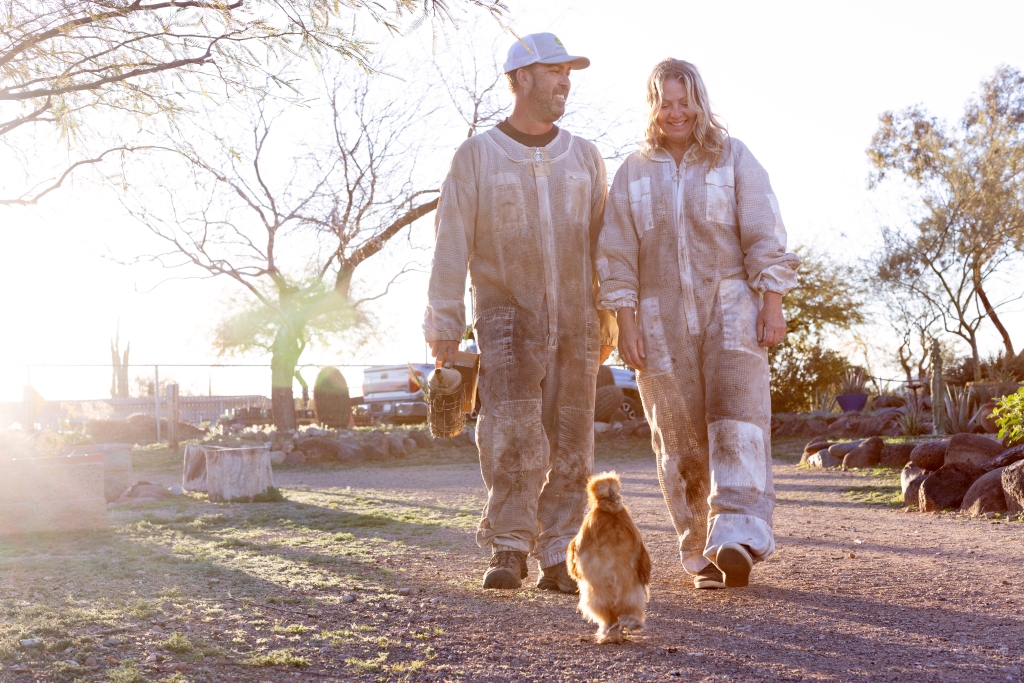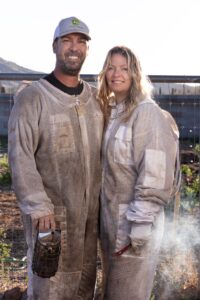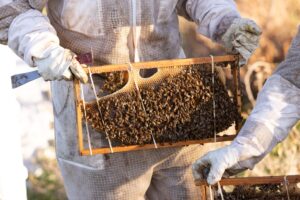Bees, Honey & A Rooster Named Chewie

Writer Shannon Severson // Photography by Loralei Lazurek



Along one of the few remaining rural roads that wind through the foothills of Happy Valley in north Phoenix, Blooming Ranch is a small oasis of flowers, carefully tended crops of fruits and vegetables, and a small menagerie of unusual pets. It’s also a source for local honey, tended in a way that preserves vital honeybee populations in our state.
When you first drive through the gates, you may find Cricket Aldridge weeding the garden beds or harvesting artichokes — yes, artichokes! Aldridge says that nearly anything that grows in a Mediterranean climate will grow here in Arizona. The large back porch of the home she shares with her husband, Rob Ungvary, also serves as a small shop, with a farmhouse-style hutch teeming with jars of the couple’s sustainably harvested honey and products handmade with honey and beeswax.
You’ll likely also see Chewie, a fluffy brown rooster of the Silkie variety. He’s literally the “cock of the walk” around the farm and very attached to Aldridge, following her every move and happy to be picked up for a cuddle. While a chicken that acts more like a loyal pup may seem unusual, his breed is also known for having other peculiar characteristics, like black skin and bones, blue earlobes and five toes on each foot. He’s smaller than a typical rooster but full of personality.
Not to be outdone by Chewie’s unusual beauty, Wylie the India blue peacock may also wander through, spreading his massive plumes and doing a little mating shimmy to show off.
Between the animals, whatever is blooming or bursting forth from the ground, the couple’s thriving bee removal service and maintenance of their own hives and clients’ hives, there’s never a dull moment on the farm.



Battle for the Queen
While Aldridge’s bees are too numerous to have individual names, she is no less passionate about beekeeping and preserving European honeybees in Arizona. Blooming Ranch keeps hives at the farm and on land near Lake Pleasant, so the couple routinely makes the drive north to check hives, provide water, and, when flowers aren’t blooming, offer supplemental nutrition for the colonies.
It’s not easy work, but it’s vital to the survival of every species on Earth, including humans. According to Planetbee.org, pollinators are necessary for the growth of 75% of our crops and contribute more than $217 billion. That’s a lot of work for little winged insects all dressed up in black and yellow, but that’s why beekeeping is more than just a hobby or business; it’s an industry necessary to the perpetuation of our world.
In Arizona, all honeybees become Africanized without careful, purposeful monitoring.
“Queens only mate once in their life,” Aldridge explains. “When a queen dies, a new queen mates with an Africanized bee, and that’s how hives become Africanized. You have to get rid of the Africanized queen and find one from somewhere else — usually Hawaii or Northern California — and you introduce her to the hive over the course of a week. We keep her contained in a special cage so she can walk around but is safe and can begin laying eggs. The bees will eventually accept her and start caring for her.”
The process of “re-queening” a hive and fully eliminating the Africanized brood takes a full three months to complete. A queen can lay 1,200 eggs per day. The new queen begins laying right away, but it takes 21 days for those Africanized eggs to hatch, and drones live six weeks. The queen is marked with a specific colored dot that is an international code indicative of the year she was born, making her easy to identify and track.
“Africanized bees are dangerous,” Aldridge says. “You could open an Africanized hive, and they will go on the attack. They can quickly kill all the animals in the neighborhood and hurt people too. Sometimes we are called out to hives that we can’t handle. You can’t just leave a hive alone; it will become Africanized.”
Hives must be checked regularly because Africanized bees are stealthy and aggressive about taking over hives—even ones that are meticulously maintained. Aldridge must work at night—when the bees are less active—to remove and, occasionally, transport Africanized hives way out into the wilderness, leaving them to re-queen for three months.
“There’s no way to totally eradicate Africanized bees,” Aldridge says. “It’s impossible, but that’s one reason it’s important to have beekeepers everywhere.”
Africanized swarms aren’t the only threat. Beekeepers lose 45% to 50% of their hives each year to varroa, a tiny mite from Asia that quickly destroys colonies. Aldridge says it’s a constant process of testing and treating, but universities like Purdue and Louisiana State University at Baton Rouge are developing varroa-sensitive hygiene queens that naturally fight off varroa mites. Hives generally require testing and treating for the parasites at least four times per year.
At $35 per queen, the cost of saving colonies can quickly escalate. Aldridge notes that Arizona no longer has an apiary inspector, unlike Florida, where a robust bee program at the University of Florida registers hives and conducts inspections and DNA tests.
“[In Florida], you can’t keep an Africanized colony,” Aldridge points out. “You must re-queen, and the state will help with monitoring diseases. They’re regulatory in a good way. I like that Florida has that because they have fewer Africanized bees. Here in Arizona, many people don’t request help with Africanized hives because it’s expensive. What I would really love is to have a beekeeper’s fund to help with the cost of re-queening.”
To support the apiary community, Ungvary created the Arizona Backyard Beekeepers Facebook group, which has grown to 5,000 members and is actually how the couple first met. The group focuses on helping new beekeepers and bee removal specialists.
“We have beekeeping meetings every month,” Aldridge says. “Many group members also perform bee removals and help spread the word about beekeeping classes. We also put together group orders for queen bees.”
The pair founded the nonprofit Arizona Honeybee Festival, which has been held each November for the past eight years. The event is “dedicated to bringing awareness to our community about the importance of honeybees to our lives.” Activities for the whole family are available, and there are educational seminars about the use of backyard pesticides that can harm bees and ways to help honeybees survive.
Aldridge also works for Best Bees, a contractor that maintains both backyard and corporate hives, including JPMorgan Chase’s Tempe headquarters’ rooftop colonies. You can also see her work at Butterfly Wonderland’s observation hive. In all her work, she is constantly collecting detailed information to share with national databases.
She continues to be in awe of the instinctual and creative nature of honeybees.
“They are amazing architects, amazing creatures,” she says. “Hives aren’t like what we see in a Winnie the Pooh cartoon. Bees always build from the top, attaching the comb high and then building down. Once the first comb is built, the queen will instantly start laying eggs. They add new comb as they go. Honey is used on the outside and top of the hive as insulation. Everything is located very specifically.”
Bees also have specific jobs throughout their lives. Young bees serve as nurses, eating pollen and producing royal jelly to feed the larvae. Bees eat the honey for energy and store the rest. The pollen is used to produce brood.
“A honeybee colony is a superorganism,” Aldridge says. “Every age has a different job. They’re [working] inside the hive for their first three weeks, then they forage for the rest of the time. Their lifespan is about six weeks.”



Treasures from the Hive
Harvesting honey is the culmination of all this vigilance. Aldridge says the Blooming Ranch honey harvest begins in earnest each spring, usually in May, when flowers sprinkle the landscape and the sun brings consistent warmth to the days, and continues through July. The boxes of their 200 hives are stacked so that there is a space for brood and honey that the bees can eat themselves. The top level is full of overflow honey, and that’s what is harvested.
“Honey is heavy,” Aldridge explains. “One box can weigh 65 to 100 pounds, so we usually remove frames that are placed in the slots of each box.”
The beekeeper removes the frame, cuts the caps off the sides and places four at a time in a centrifugal spinner that removes the honey by gravity, then the frame is replaced in the hive. Alternatively, honeycomb in the frame can be crushed and strained.
“It takes 8 pounds of honey to make 1 pound of wax,” Aldridge says. “When the flowers are gone in June or July, that’s the time to harvest wax from the extra box, which I use to make salves and candles.”
Blooming Ranch produces a range of products in addition to hundreds of pounds of honey, including beeswax candles and body products. Aldridge says honey has many applications, including healing properties. When put on a cut and covered with a bandage, glycolic acid mixes with moisture in the wound to produce its own version of hydrogen peroxide, creating a continuously healing environment beneath the bandage.
“I make Power Salve for humans, Honey Paws salve for pets and a bug bite balm,” Aldridge explains. “I wild-forage jojoba and extract the oil with an oil press. It’s infused with creosote, which is super medicinal, then I use my own beeswax to create a product that is soothing, protective and antimicrobial.”
Aldridge loves to share her bounty and knowledge with the public. She hosts beekeeping classes to educate others about how to get started and leads classes to teach people to make their own salve at her “Open Farm” days each Friday from 9 a.m. to 11 a.m. Open Farm days are an invitation to come observe or participate. Visitors can help in the garden, pet the chickens, learn a project, or just enjoy the environment.
bloomingaz.com // gardenvarietybees.com // azhoneybeefest.org
Open Farm Days
Fridays // 9 a.m.–11 a.m. // Blooming Ranch // 25626 N. Seventh Ave., Phoenix // Free // bloomingaz.com

